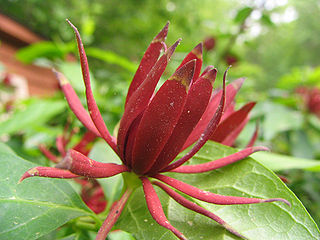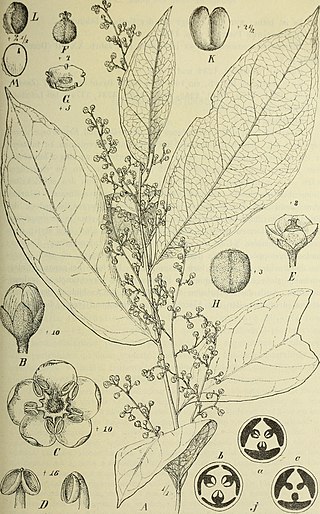
Nartheciaceae is a family of flowering plants. The APG III system places it in the order Dioscoreales, in the clade monocots. As circumscribed by APG IV (2016) it includes 35 species of herbaceous plants in the following five genera:

Basellaceae is a family of flowering plants in the order Caryophyllales, in the clade core eudicots, according to the Angiosperm Phylogeny Group. The family comprises 19 known species of herbaceous plants in four genera:

The Calycanthaceae are a small family of flowering plants in the order Laurales. The family contains three genera and only 10 known species, restricted to warm temperate and tropical regions:

The Clethraceae are a small family of flowering plants in the order Ericales, composed of two genera, Clethra and Purdiaea, with approximately 75 species. They are native to warm temperate to tropical regions of Asia and the Americas, with one species also on Madeira.

Bonnetiaceae is a family of flowering plants, consisting of 4 genera and 41 species. The family is Neotropical, with the exception of the genus Ploiarium, which is found in Malesia. It is sister to the family Clusiaceae.

Caryocaraceae is a small family of flowering plants consisting of two genera with 26 species. The family is native to tropical regions of Central and South America, as well as the West Indies.
Ctenolophon is the only genus in the flowering plant family Ctenolophonaceae. It has two recognized species:

Dichapetalaceae is a family of flowering plants, consisting of 3 genera and about 170 species. Members of this family are trees, shrubs or lianas found in tropical and subtropical regions of the world.

Erythroxylaceae is a family of flowering trees and shrubs consisting of 4 genera and 271 species. The four genera are AneulophusBenth., ErythroxylumP.Browne, NectaropetalumEngl., and PinacopodiumExell & Mendonça. The best-known species are the coca plants, including the species Erythroxylum coca, the source of the substance coca.

Humiriaceae is a family of evergreen flowering plants. It comprises 8 genera and 56 known species. The family is exclusively Neotropical, except one species found in tropical West Africa.

Circaeasteraceae is a family of two species of herbaceous plants native to China and the Himalayas.

Myrothamnus is a genus of flowering plants, consisting of two species of small xerophytic shrubs, in the southern parts of tropical Africa and in Madagascar. Myrothamnus is recognized as the only genus in the family Myrothamnaceae.

The Thurniaceae are a family of flowering plants composed of two genera with four species. The botanical name has been recognized by most taxonomists.

Staphyleaceae is a small family of flowering plants in the order Crossosomatales, native to Europe, temperate and tropical Asia and the Americas. The largest genus Staphylea, which gives the family its name, contains the "bladdernut" trees. The family includes three genera with more than 40 known species.

The Ecdeiocoleaceae comprise a family of flowering plants with two genera and three species. The botanical name has rarely been recognized by taxonomists.

Salvadoraceae is a family in the plant order Brassicales, consisting of three genera with a total of 11 known species. They occur in Africa, Southeast Asia, and on Java, suggesting they are probably found in much of Malesia. They are often found in hot, dry areas.

Kirkiaceae is a family of flowering plants in the order Sapindales. It comprises one genera, Kirkia, totalling six species. These two genera were previously placed in family Simaroubaceae, but were transferred into their own family because they produce neither quassinoids nor limonoids. Kirkia is named for Captain John Kirk (explorer) of the famous Zambesi Expedition.

Huaceae is a family of plant in the rosids group, which has been classed in the orders Malpighiales, Malvales, and Violales or in its own order Huales. The APG II system placed it in the clade eurosids I, whereas the APG III system of 2009 and APG IV (2016) place it within the Oxalidales. The family is endemic to central Africa. It contains four species in the following two genera:

Calophyllaceae is a family of flowering plants in the order Malpighiales and is recognized by the APG III system of classification. Most of the 14 genera and 475 species included in this family were previously recognized in the tribe Calophylleae of the family Clusiaceae. The Angiosperm Phylogeny Group determined that splitting this clade of genera off into their own family was necessary.

Centroplacaceae is a family of flowering plants in the order Malpighiales and is recognized by the APG III system of classification. The family comprises two genera: Bhesa, which was formerly recognized in the Celastraceae, and Centroplacus, which was formerly recognized in the Euphorbiaceae, together comprising six species. The Angiosperm Phylogeny Group determined that based on previous phylogenetic analysis, these two genera formed an isolated clade and recognition of the family was "reasonable."



















